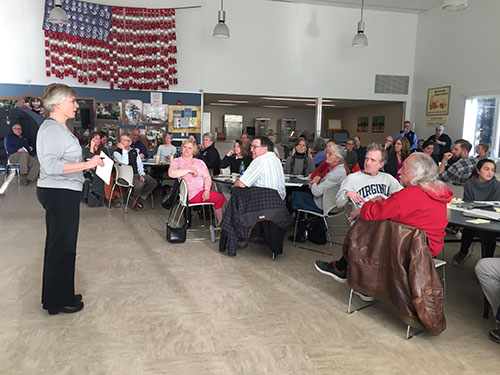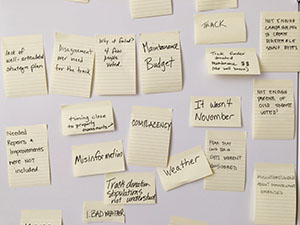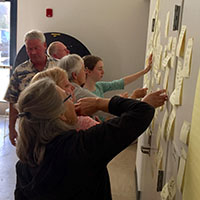— by Ayn Gailey —
 Where do we go from here? That was the question of the evening on Thursday, Mar. 30 at the first community forum since the Orcas Island School District’s (OISD) Phase III Bond was defeated by a mere three votes back in February.
Where do we go from here? That was the question of the evening on Thursday, Mar. 30 at the first community forum since the Orcas Island School District’s (OISD) Phase III Bond was defeated by a mere three votes back in February.
The forum was well-attended by residents for and against the last bond attempt, parents and non-parents, teachers, and young and old islanders. It was also a glowing example of one of our island’s best attributes: working together to do what’s best for our community. So, too, the event’s activities made it clear that although the bond’s focus is on providing important improvements to our public schools, it also provides improvements to our entire community that can benefit everyone, whether you have a child enrolled in our schools or not.
OISD superintendent, Eric Webb, opened the forum by welcoming everyone and emphasizing how important community input is to the process of getting a new bond on the ballot in November. And, because some find the difference between bonds and levies confusing, Webb shared an informative video on the matter to quickly explain the difference between the two. Webb also informed the crowd that the school is moving ahead with the HVAC design before the next bond vote because getting heat to the high school students is critical.
The School Board was also present to hear input in order to help them figure out what needs to change to get to a majority in order to get the bond to pass the next time around.
Lisa Byers did a great job facilitating the rest of the meeting, keeping participants active and engaged in the process. “Tonight is not a night about blame,” she shared, then challenged everyone in the room to do some “industrial strength listening,” as she called it. Her goal was that everyone, whether they were for or against the last bond, “leave the forum thinking about things just a little bit differently.”
Councilman Rick Hughes, who participated alongside his neighbors, mentioned that the upcoming Phase III School Bond is one of the most important things we can invest in over the next ten years. “We have the chance to create something amazing for the whole community,” he emphasized.
 Attendees were asked to think of up to three reasons they thought the bond did not pass, then were instructed to write their reasons on a Post-it and place all Post-its on the wall. Following that exercise, individuals were invited to approach the wall of Post-its and clump them into themes. Together, the group dwindled the themes down to the following five then broke out into teams and generated recommendations.
Attendees were asked to think of up to three reasons they thought the bond did not pass, then were instructed to write their reasons on a Post-it and place all Post-its on the wall. Following that exercise, individuals were invited to approach the wall of Post-its and clump them into themes. Together, the group dwindled the themes down to the following five then broke out into teams and generated recommendations.
[Note: Please keep in mind that this is only the first of other upcoming informational meetings to generate recommendations to the school board.]
Inadequate Campaign
Attendees felt lack of communication around the bond was an issue that contributed to its defeat. One of the recommendations was to create a coordinated campaign committee to outreach to a diverse set of islanders that would emphasize providing information to those who have not attended previous forums. It was recommended that future forums be held at other island locations to reach a more diverse group. The group also thought that exploring other mediums such as Facebook or a dedicated website to reach more people and contain more bond information, was definitely worth exploring.
Maintenance: There was a consensus that there was an erosion of trust between the school and the community because some citizens don’t understand why simple things are not fixed at the school. The group working on this issue also thought that the school needs a maintenance manager to stay on top of repairs. Some of the recommendations to build up trust between the school and the community was to hire or assign a maintenance manager; encourage the school to provide a quarterly report on maintenance. It was recommended that the report list items that need to be fixed, items that have been fixed; and if items have not been fixed, the report should provide an explanation providing the reason why not.
Low Voter Turnout
The Post-its created by attendees listed a variety of reasons why there may have been lower voter turn out than usual, including but not limited to heavy snow days, difficulty getting to the post office, the early closure of the post office. It was also noted that many people knew citizens and parents at the school who assumed the bond would pass, therefore did not vote. Recommendations were to create a campaign committee and encourage voter registration.
Controversy & Lack of Clarity Around Track
Attendees felt that the large budget item left a lot of people confused and unsure. Some seemed unsure or were not convinced that this kind of expense should be a school priority. Others felt there was a lack of information about the value that the track and field held for the entire community beyond the kids enrolled in school. For instance, community members could use the track as a safe walking or running path and the fields could be used for soccer and football. And, lastly, the fact that a private donor was offering $1m to offset the costs may not have been widely known. Recommendations were to inform voters of what is actually being created and what is being replaced (e.g. the inadequate and dangerous conditions of the current field system); less emphasis on the track itself; and communicate that the proposal also includes a football field, and other essential fields that could be used by the entire community. Additionally, the attendees urged that the board better inform the public about the future cost of the long-term maintenance of the track and fields, which would be covered by an endowment.
Tax
Some in attendance stated that the tax ramifications for homeowners might have contributed to lack of support of the Phase III Bond. Also falling under this category, it was mentioned that the “What’s In It For Me?” mode of thinking could be related to the tax issue. Some of the ideas thrown out to address this were to better inform homeowners how little they would actually have to pay every year, make it known that many items in the plan actually benefit the community as a whole, and educate real estate owners and other citizens on how building better schools not only is the right thing to do, but helps make island living more attractive to families and property buyers and raises local real estate values for everyone.
For a history of the school bond, please visit this article: https://theorcasonian.com/school-board-passes-resolution-8m-bond-levy/
**If you are reading theOrcasonian for free, thank your fellow islanders. If you would like to support theOrcasonian CLICK HERE to set your modestly-priced, voluntary subscription. Otherwise, no worries; we’re happy to share with you.**









How do the track and fields to be used by the entire community fit into the school bond alone and not the recreation levy system? Is it possible to have the Parks and Rec District participate in support of the facilities?
Very good point. School bond should only be for school
purposes. The Board needs to go for a sure thing in November and remove the track from the Bond request.
It would also be important to know what else needs improvements on the school grounds after this proposed bond.
I agree Pierrette . . . I believe if the track were removed from the levy/bond then it would pass. I wonder if the donor would still donate for the track if it were not on the levy but merely a donation to make it happen? If there were adequate funds to build and maintain the track with the donation then why did it have to be included at all? As a voter it seemed as if they were saying it was covered by donation but then wanted it on the bond as well, which did not then or now make sense to me.
Ah, but what about the library holding book sales in the cafeteria? Volleyball, pickle ball, rollerskating, rec-league basketball, paper airplane contests, etc having after hours events in the gyms??? Shouldn’t we have other uses of the school when appropriate? All of the meetings that I have attended have had some Park and Rec leaders present. The school bond proposal is set to take care of the fields (that have been badly neglected over the years and really were not constructed in a maintainable way in the first place…this proposal would actually get the fields to a maintainable, safe, useable level for a very reasonable price for the average household). The track is a donation to the school and the donor family already has given an endowment to the school, not to Park and Rec for a maintenance fund!!!!
Andrew–I was simply asking what are the relative responsibilities of the two taxing districts. Obviously, the community has always had access to the school infrastructure for incidental uses. As I understand it, the track cost is covered by a donation, and maintenance of the track is potentially covered by an endowment, but the cost of the field reconstruction is not.
As far as the fields (baseball/softball, soccer, football, PE, etc) there is an agreement that the Park and Rec/School leaders can answer specifically. I do know that the school ‘uses’ the P&R fields for High School and Middle School baseball/softball presently, with a formal agreement as to the use and maintenance as well as P&R ‘uses’ the school’s fields for Little League, etc. That is just for spring activity as an example. For winter the school obviously uses their ‘own’ gym for the school basketball teams, but then has an ‘agreement’ with P&R to use the gyms on off use hours for the P&R basketball teams (that is just an example for the kids, not even the adults). My point is that there is a significant over-lap in the present use of the existing facilities (and since I am not on either board I do not know the specifics of the relationship)!
Marla- The track build out is covered fully by the donation and the track maintenance would be fully covered by the distribution from the endowment. The Bond included redoing all the play fields for soccer, football, baseball and practice fields. The track would be used by multiple sports disciplines as well as general PE classes. As a bonus, it would also available to the community for walking, running and interval training. As for this being a ‘school’ program, we are fortunate to live in a time where we recognize the need to provide more than the basics to our students, recognizing that art, music, culinary arts, woodworking and sports provide valuable connection and experience for our students. The fields are in dire need of repair and the track is a great gift. Seems like a win-win for our community.
Peg Manning, on March 23, you said: “The track is not 100% a gift.” Now you say, “the track cost is covered by a donation, and maintenance of the track is potentially covered by an endowment”. Glad that you’ve come around! (And BTW, maintenance of the track will be close to $0.)
I don’t know enough about this discussion to weigh in, but I’m heartened by the discussion going on, the community forms going on to let the people help solve the issues we have, and I very much appreciate and condone the overlap of uses on school grounds. To have the bond lose by only 3 votes proves that there is support for it. Voter turnout should be a no-brainer, due to being able to mail in our ballots and drop them off at the senior center, so it seems an education campaign and helping folks who are snowed-in, if a ballot item has a vote in a winter month, would be two good solutions to passing the bond in November.
I have never been an athlete, nor invloved with team sports, but I see the importance of them – both for building team work and participation, as well as a way to excel physically.
I think the bottom line is that our students and their needs must come first, and I hope we can all support the idea that in a small community, overlap and shared uses of buildings and land, especially in Eastsound where there is so precious little, is paramount. I consider the track and fields a necessity, both for students and for the larger community.
I am not sure how insurance is set up in our school, but I know that in other schools, use of the rooms after hours for other activities is encouraged and condoned, and a small rent is charged by the school. Might these after hours and summertime activities increase, and the rental be used to help pay for any further janitorial maintenance involved, say, after evening activities such as classes, work groups, and the like?
We can always use more meeting places, too. Could we have a lot more independent study classes and experimental-college classes meet at the school; say, evening art, poetry, and music classes, University credit classes, ESL classes, and Spanish classes, for instance?
Thank you, Hilary, for the information about the maintenance costs. I didn’t realize that the endowment was restricted to maintenance costs.
The endowment is NOT restricted to maintenance costs.